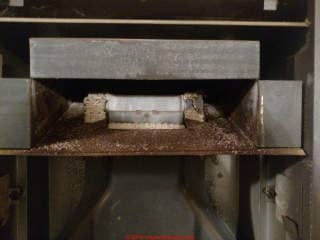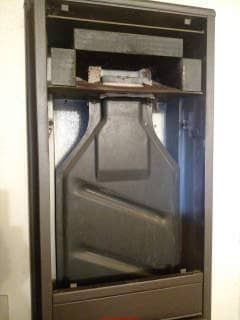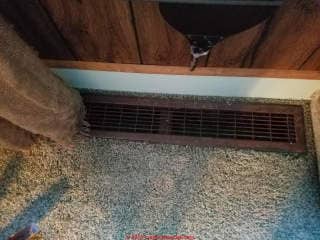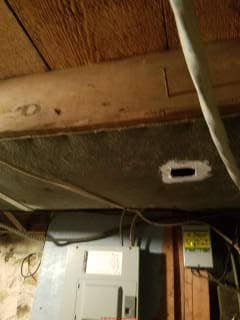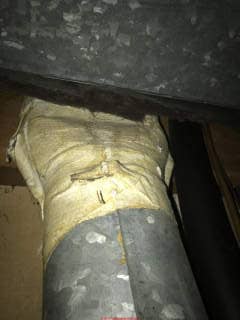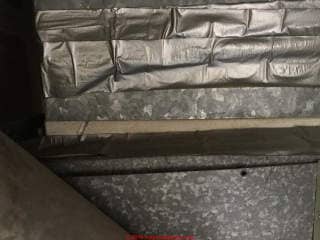 Asbestos HVAC Duct & Blower Unit FAQs#2
Asbestos HVAC Duct & Blower Unit FAQs#2
Q&A on Asbestos In Heating and Cooling Ducts & Air Handlers
- POST a QUESTION or COMMENT about asbestos materials on or inside of heating or air conditioning air ducts or air handlers & blower units
Recent FAQs on the presence of & hazards associated with asbestos in or on HVAC ducts (air ducts or heating and cooling ductwork) or inside the air handler (blower unit).
This article series describes the inspection of heating and air conditioning ducts for visual evidence of asbestos materials in or on HVAC ducts.
Page to photo: white asbestos paper used as an insulating wrap on the exterior of an air supply register box.
InspectAPedia tolerates no conflicts of interest. We have no relationship with advertisers, products, or services discussed at this website.
- Daniel Friedman, Publisher/Editor/Author - See WHO ARE WE?
Asbestos Materials on or in the Air Conditioning or Heating System Duct Work
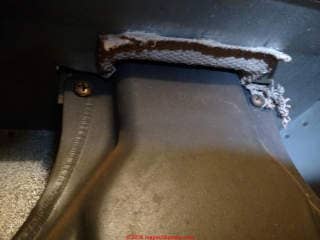 These questions & answers about the hazards of asbestos on or in HVAC ducts or air handlers were posted originally
These questions & answers about the hazards of asbestos on or in HVAC ducts or air handlers were posted originally
at ASBESTOS DUCTS, HVAC - be sure to review that article.
On 2018-12-12 by (mod) - OPM Other People's Money - asbestos advice & risk management
CG
If there is asbestos fabric right in the indoor air path, that's not desirable.
I suspect that because it (looks like) a fabric the material may not be very friable and the actual indoor airborne asbestos level might be very low or even not detectable. Still you don't want this in your air path - it could shed asbestos in response to mechanical disturbance, damage, or other events.
Unfortunately this is a dark example of the "OPM" problem - Other People's Money - when you ask someone what to do about something that MIGHT involve a risk to you, they are inclined to reduce THEIR liability by telling you to spend YOUR money to do the absolutely-safest thing - even though it's costly.
In other words you're probably be going to be told to replace the heater. Modifying it not only risks releasing more asbestos into the occupied space but also voids the manufacrturer's warranty (if one remains) and might even make the heater unsafe, risking CO (fatal carbon monoxide) leaks - depending on just what this asbestos fabric is doing - I can't really be sure from just your photos.
Ugh.
See details at ASBESTOS USE in AIR CONDITIONERS
On 2018-12-11 by C George
thank you for your assessment. It's a small apartment and much of our air coming into the apartment comes through this duct when we have any exhaust fans on.
One can stand in front of the furnace and feel outside air coming through it. After we weatherproofed the appartment and sealed other air leaks, it became the primary outside air supply.
On 2018-12-11 by (mod) - asbestos used in 1970's gas wall furnace
C George
Yes I think it's likely that that fabric material is asbestos.
Is that in the actual air path of building air? If not it's probably not likely to produce measurable airborne asbestos in the building.
Do not try modifying the furnace -doing so may be usafe.
On 2018-12-11 by C george
maybe a better shot of the upper half of the unit. - shown above.
A braided fabric like material between the metal elements of this upright gas burning heater. This is twords the top and subject to high heat. Also a major point of air supply for living area.
On 2018-12-11 (mod) - is this asbestos in my 1970's wall furnace?
It's certainly possible. The photos of it blurry so I can't quite make out what we're looking at.
On 2018-12-11 by C george
Hello, I was wondering if this can be visually identified as asbestos, or might have used asbestos for this type of material from the 70s
. I found this insulation material degrading within my in-wall gas burning furnace placed centrally in our living room, wondering about exposer possibility and identification options, thank you.
On 2018-11-09 by Anonymous
Thanks dan.
On 2018-11-09 by (mod) - a high probability of asbestos in the tar paper or fiber glass?
There may be asbestos in the "tar paper" aka "felt paper" or "roofing felt".
On the outside of ducts and more-so atop fiberglass, the chances that any particles from the felt paper are entering the air blowing through supply ducts is close to zero.
There would not normally be asbestos in fiberglass insulation.
Much felt from the 1950's contained asbestos but I can't say with authority that all of it did.
On 2018-11-09 by John Anderson
We have a forced air heating duct system that is covered in a fiberglass insulation. It is not covered in any white paper as shown in the photos. But it seems that the fiberglass is wrapped with tarpaper 10.
House is from the 1950s.
Question: in your opinion, does this mean a high probability of asbestos in the tar paper or fiber glass?
Follow up question: Did ALL tar paper during that time use asbestos or was it used regularly but not always?
Going to get it checked one way or another.
On 2018-10-31 by (mod) - Moving Cooler air from the occupied space through the furnace in order to be heated and blown back into the occupied space means that all of your house air is being run through that asbestos-fabric-covered return duct.
No Jason, at least from the little I can see of the edge of the material that looks like a plastic or foil-covered yellow fiberglass. Take a closer look yourself and let me know what you find.
On 2018-10-31 by Jason b

Hey guys, so I have this tape on my ducts but it’s not white. It’s more silver but covering some yellow glue. I know what the white tape looks like as I’ve taken it out of another house.
Does this look like asbestos ?
On 2018-10-14 by (mod) - do not use asbestos fabric HVAC ductwork
Watch out: No that sounds like a return air duct
The photos suggest - obviously I can't see much of your house - that you have a central air return inlet (that floor grille) that's moving house air through a return duct constructed using an asbestos fabric nailed across a pair of floor joists.
Moving Cooler air from the occupied space through the furnace in order to be heated and blown back into the occupied space means that all of your house air is being run through that asbestos-fabric-covered return duct.
Even though asbestos fabric, un-damaged, sheds asbestos fibers less than softer asbestos materials that may be more friable, moving house air across an expanse of high asbestos-content cloth forming one large surface of the return air duct creates a significant (in my OPINION) risk of shedding asbestos into the building air.
It would make sense to abandon that ductwork and use new clean return ducts.
In sum I think your photos show a return air inlet for a heating or air conditioning system . Locate that same area from the floor below: you should see ductwork leading back to your furnace or A/C air handler. That's not combustion air. That's house air that you breathe.
On 2018-10-13 by Theresa Radachowsky
The duct is in our living room and does not bring in air from outside.
I believe it is air for combustion.
With that said. Today I sprayed the area directly inside the vent with poly to seal it where it is close to the living space.
I used aluminum tape to seal up the hole I cut in the cellar and will spray with sealer as soon as it dries out enough.
Next year, when the pool equipment is out again, I will seal and cover it with flashing.
Sounds good?
the duct is from the floor of our living room directly to the furance.
If I read you correctly, that would be used for combustion purposes as it does not draw outside air into our home.
Correct?
On 2018-10-11 15:27:25.407337 by (mod) -
In my opinion, yes, IF the air is being used to vent outside air into the occupied space. Sending air over a soft or friable asbestos surface and onwards into the building is risky business.
In that case:
You could use a duct lining spray service along with a very thorough camera inspection of all of the duct passage.
I would consider abandoning the duct, covering it over, and making a new duct system and source nearby, or at higher cost and risk, having the material removed and the surfaces cleaned.
IF however the outside air is simply providing combustion air to the furnace oil or gas burner, and none of that air is moving into occupied space, the hazard to you from the arrangement is likely to be beneath the limits of detection. IN that case you'd cover the exterior of the material.
On 2018-10-10 by Theresa Radachowsky - asbestos fabric return ducts 65% asbestos.
Our older home has a fresh air vent made by stapling what we thought was cardboard over the floor joists.
We just found out after sending a sample to the lab, it is 65% asbestos.
People have suggested painting it and enclosing it in aluminum both methods do not deal with the interior portion.
Do we have a problem?
There is no forced air in these vents but they do lead to the furnace.
What is a reasonable way to deal with this?
On 2018-07-18 by (mod) - asbestos sampling
Phyllis,
There are approved and safe methods for sampling asbestos suspect materials, and a certified asbestos test lab can certainly identify asbestos reliably.
Adding: post some sharp photos of the ductwork here and perhaps we can comment further.
On 2018-07-16 by Phyllis hastings
I just rented a house that has asbestos on the inside of the ducting and cardboard on the outside.
The owner will not do anything about it unless I prove it. The asbestos consultant said to prove it would compromise it as he would have to sample it by cutting it . Another consultant said they would do tem's testing and air sampling and take a sample from the registers. I live in CA.
I have already spent $500 for the 1st consultant and now to hire another 1 will be another $ 700 and I have only lived here 3 weeks and I am just the tenant
To remove it is $800 plus installation ( 3,300 ) CAN IT BE PROVEN SCIENTIFICALLY ? If I can prove its friable then the owners MUST remove it
On 2018-07-12 by (mod) - how inspectors deal with non-visible areas of ductwork
in a typical Home Inspection the inspector will exclude areas that are not accessible, and if she is doing her job correctly will advise you to those exclusions and explain the reasons why as well as offering any exterior clues that suggest that further more invasive inspection is appropriate.
For a specialty inspection you need to negotiate that question ahead of time. Obviously the inspector doesn't have X-ray vision.
However there are inspection cameras that can be used if it's Justified. certain amount of rational thinking can reduce the cost of such an investigation.
For example if you see suspicious material and an accessible area would be more concerned about suspicious material in other areas. And vice versa.
On 2018-07-12 by Remo
Thanks Mod. We will get the possible places tested and then appropriately abated.
If you don't mind, could you comment on how inspectors typically investigate whether the ducts that are enclosed in soffits have any asbestos tape on the joints? Or is that something not done during such inspections?
If the ducts inside the soffits have asbestos tape, does that present a danger?
On 2018-07-12 by (mod) - asbestos, duct tape, fiberglass - various HVAC air duct treatments
Looks as if there is asbestos paper on the duct at the register (picture 2), and possibly an asbestos fabric at the vibration duct dampener - picture 1
Pink fiberglass insulation is not an asbestos product.
On 2018-07-12 by Remo
Photo showing Soffit enclosing the ducts and the pink insulation around the duct.
On 2018-07-12 by Remo
Picture 2
On 2018-07-12 17:50:37.325947 by Remo
- The one with a bit of tape peeking through is where the sheet metal plenum on top of the furnace joins the furnace - it appears as if previous owner has simply taped over the underlying white tape. Not sure if that is asbestos tape.
- The one with large amount of tape is at the funnel-shaped end of the flue - close to the ceiling of the furnace closet.
That seems to be fraying a bit as well, so we are worried (what can we do until we get an inspector there?) We didn't touch it of
course.
- The one with the taped register is simply to show that the ducts are all concealed in the drywalled soffit - so how will the inspector look at these ducts and see if there is asbestos tape on the joints? Will he have to cut a drywall section?
- The one with pink insulation is where the trunk above the furnace meets the horizontal ducts (we are hoping this type of pink insulation isn't asbestos containing) Do we need to test this as well?
On 2018-07-12 10:21:13.814576 by (mod) -
Pethaps you could show us a photo or two?
On 2018-07-11 14:49:59.384123 by Remo
Our home was built in early 1970s. We have sheet metal ducts (I opened the registers and see that the ducts are sheet metal, the plenum etc is also sheet metal).
The ducts are enclosed in soffits.
The flue from the gas furnace seems to have some type of white tape (now yellowing in places, and brown/rusty in some places) wrapped on the joints and on the funnel-shaped cone going into the ceiling.
We don't know if that is asbestos tape - I have read that it can be. So we want to get it checked.
But, the question is - if we want to get the ducts checked for asbestos duct tape on joints, how does the inspector do that if the ducts are enclosed in soffits?
Also, we see some pink fibrous stuff backed by some yellowish paper surrounding the ducts once I remove the registers. That is likely fiberglass, correct? Thanks a lot for your help and this is a very good site.
On 2018-03-07 20:56:44.778074 by (mod) -
Reply:
My advice, to rest your concern, is to collect a representative dust sample and have it analyzed by an asbestos test lab.
https://inspectapedia.com/hazmat/Asbestos_Test_Lab_Lists.php
Anything else is pure speculation.
Following up on other questions you raised:
Should the dust sample be tested using TEM method? (I know its more expensive, but I want to do this right).
IMO any certified, licensed microscopy/environmental lab can use any of several methods including PLM that are perfectly reliable and adequate. TEM is not necessary to identify asbestos
- I will find "old dust" to degree possible. But should I also get dust samples from inside my HVAC? My house is 2008, but if there was asbestos dust in the contaminate that came into our house, is this where it would most likely settle?
Candiate dust samples include a horizontal surface that has not been wiped clean and is in an area where you spend much time, and yes, an inside surface of the air handler or ductwork, perhaps in the return plenum, or from a filter surface.
- Would asbestos dust still be present 5 years later?
Asbestos dust would not be expected on surfaces that have been cleaned since the *possible* release of asbestos-containing dust in the home but would easily be present in old dust samples from the same era. It doesn't evaporate nor disintegrate.
- Is it true that most homes built in the asbestos-era (ie. 60s or 70s) would have asbestos dust in the HVAC/ducts from original home construction? Has anyone ever tested this 'theory'?
I'm not aware of research focused exactly on your question but will pursue it.
IMO it is not likely that there would be meaningful levels of asbestos in house dust in a home and probably not a detectable level of asbestos in dust in a home attirbutable to asbestos paper duct wrap on an HVAC system if that wrap was not disturbed, cut, ground, sawn etc. to make a dusty mess.
...
Continue reading at ASBESTOS DUCTS, HVAC or select a topic from the closely-related articles below, or see the complete ARTICLE INDEX.
Or see ASBESTOS DUCTS, HVAC FAQs-3 - more-recent questions & answers about asbestos hazards in HVAC ductwork
Or see these
Asbestos HVAC Duct Articles
- ASBESTOS HVAC DUCTS - Guide to Identification of Asbestos Materials On or In Heating and Cooling Duct Work: carbon monoxide hazards of transite chimneys and vents
- ASBESTOS TESTING LAB LIST if you need to have asbestos-suspect material tested
- DUCT SYSTEM DESIGN SIZE & DEFECTS
- DUCTWORK CONTAMINATION
- IDENTIFICATION of ASBESTOS in buildings - Asbestos Identification in buildings: How to find & identify asbestos-containing materials
- TRANSITE PIPE AIR DUCT ASBESTOS RISKS - Hazards of Asbestos-containing Transite Pipe HVAC Ducts: duct collapse, mold, radon, asbestos fiber release
- TRANSITE PIPE CHIMNEYS & FLUES - Guide to Identifying Asbestos Transite Chimneys & Flues & their Hazards in buildings
- TRANSITE PIPE WATER SUPPLY PIPING - Guide to Identifying Asbestos Cement Transite Water Pipes & their Hazards in buildings
- VIBRATION DAMPENERS - asbestos gaskets and vibration dampers in duct work
Suggested citation for this web page
ASBESTOS DUCTS, HVAC FAQs-2 at InspectApedia.com - online encyclopedia of building & environmental inspection, testing, diagnosis, repair, & problem prevention advice.
Or see this
INDEX to RELATED ARTICLES: ARTICLE INDEX to ASBESTOS HAZARDS
Or use the SEARCH BOX found below to Ask a Question or Search InspectApedia
Ask a Question or Search InspectApedia
Questions & answers or comments about asbestos materials on or inside of heating or air conditioning air ducts.
Try the search box just below, or if you prefer, post a question or comment in the Comments box below and we will respond promptly.
Search the InspectApedia website
Note: appearance of your Comment below may be delayed: if your comment contains an image, photograph, web link, or text that looks to the software as if it might be a web link, your posting will appear after it has been approved by a moderator. Apologies for the delay.
Only one image can be added per comment but you can post as many comments, and therefore images, as you like.
You will not receive a notification when a response to your question has been posted.
Please bookmark this page to make it easy for you to check back for our response.
IF above you see "Comment Form is loading comments..." then COMMENT BOX - countable.ca / bawkbox.com IS NOT WORKING.
In any case you are welcome to send an email directly to us at InspectApedia.com at editor@inspectApedia.com
We'll reply to you directly. Please help us help you by noting, in your email, the URL of the InspectApedia page where you wanted to comment.
Citations & References
In addition to any citations in the article above, a full list is available on request.
- In addition to citations & references found in this article, see the research citations given at the end of the related articles found at our suggested
CONTINUE READING or RECOMMENDED ARTICLES.
- Carson, Dunlop & Associates Ltd., 120 Carlton Street Suite 407, Toronto ON M5A 4K2. Tel: (416) 964-9415 1-800-268-7070 Email: info@carsondunlop.com. Alan Carson is a past president of ASHI, the American Society of Home Inspectors.
Thanks to Alan Carson and Bob Dunlop, for permission for InspectAPedia to use text excerpts from The HOME REFERENCE BOOK - the Encyclopedia of Homes and to use illustrations from The ILLUSTRATED HOME .
Carson Dunlop Associates provides extensive home inspection education and report writing material. In gratitude we provide links to tsome Carson Dunlop Associates products and services.


